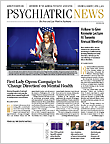“The complete giving of oneself to another person touches the essence of what it means to be human.”
So begins a chapter on sexual disorders in the new Understanding Mental Disorders: Your Guide to DSM-5, to be published by American Psychiatric Publishing (APP) in May. The new manual is a layperson’s guide to the text that was published for clinicians in 2013; the guide covers all of the disorders in the clinician’s manual and roughly follows the same developmental scheme in the arrangement of chapters, providing a “lifespan” approach to understanding diagnosis.
The chapter on sexual disorders is followed by a separate chapter on gender dysphoria. (For information about the first 12 chapters in the manual, see preceding issues of Psychiatric News.)
The opening lines to the chapter on sexual disorders continue in the same elegant but simple style: “[O]f all our contact with others, sexual intimacy can be the most rewarding,” the book states. “Although it can provide intense joy, it also can produce distress.”
The new guide explains that because sexual response involves the body, mind, and emotions, often more than one factor is involved—including problems related to one’s partner, the relationship in general, individual factors (such as aging, poor body image, low self-esteem), cultural or religious factors, and medical factors.
The disorders covered in the chapter include substance/medication-induced sexual dysfunction, erectile disorder, premature (early) ejaculation, female orgasmic disorder, delayed ejaculation, genito-pelvic pain/penetration disorder, female sexual interest/arousal disorder, and male hypoactive sexual desire disorder.
Robert Hales, M.D., editor-in-chief for books at APP and one of a six-member panel of editorial advisers who oversaw the writing and editing of the new guide, said the actual changes to criteria in the chapter on sexual disorders are few—mainly the addition of gender-specific sexual dysfunctions and the combination of female sexual desire and arousal disorders into a new disorder known as “female sexual interest/arousal disorder.”
To improve precision regarding duration and severity and reduce the possibility of overdiagnosis, all of the DSM-5 sexual dysfunctions except substance/medication-induced sexual dysfunction now require a minimum duration of approximately six months.
The chapter is sure to be of interest to the public, and Hales believes psychiatrists will be doing their patients a favor by referring them to the new publication. “Rigorously reviewed by experts with a variety of clinical perspectives, Understanding Mental Disorders presents sometimes complex information in readable, user-friendly language,” he told Psychiatric News. “Mental health professionals can assure their patients that APA’s official manual represents the most accurate, up-to-date, evidence-based information available in the field.”
A characteristic feature of the new manual is its inclusion of “user-friendly” tools, such as the “Key Points” that accompany each chapter. Here are the key points given for sexual disorders:
•
Sexual intimacy involves the whole person and can bring great joy. Sexual dysfunctions disrupt the ability to respond to sexual activity or to enjoy sex.
•
These problems occur for many reasons, which can affect how the disorder is diagnosed and treated. Quite often, more than one factor causes a sexual dysfunction. These include health problems, medications, poor body image or low self-esteem, and relationship issues (such as lack of trust or communication).
•
Treatment for sexual dysfunctions takes into account all the factors that can cause these problems and that are unique to each person and his or her partner. There may be medications that can be taken or changed, medical conditions to be treated, techniques to learn, and behaviors to help build trust and communication.
•
Drugs, alcohol, and tobacco can impair sexual response.
•
Other ways to improve sexual health include getting regular exercise (boosts stamina, mood, and self-esteem), coping with stress (so it won’t distract from sex), and sharing feelings and preferences (to build closeness and learn what pleases the other).
Gender Dysphoria Replaces GID
Psychiatric understanding of gender has evolved considerably in recent years, and the creation of a chapter on gender dysphoria reflects that evolution. Gender dysphoria is a new diagnosis in DSM-5—and a chapter unto itself—replacing the DSM-IV diagnosis of gender identity disorder and reflecting a new conceptualization of individuals who seek treatment for problems related to gender.
Criteria for the new category emphasize the phenomenon of “gender incongruence” rather than cross-gender identification. By separating it from sexual dysfunctions and paraphilias (with which it had been included in
DSM-IV in a chapter titled “Sex and Gender Identity Disorders”), the
DSM-5 Task Force hoped to diminish stigma attached to a unique diagnosis that is used by mental health professionals but whose treatment often involves endocrinologists, surgeons, and other professionals (
Psychiatric News, April 5, 2013).
“For many people, their gender is never something to question or a source of conflict for their sense of identity,” the chapter begins. “Other people strongly identify themselves as a member of the opposite sex. They have great distress that their physical gender does not match the way they think and feel about themselves. This distress and sense of conflict are described as gender dysphoria. The gender that fits with the way they feel is called their experienced/expressed gender, and the gender they were born with is called their assigned/natal gender.”
The chapter covers gender dysphoria in adults, teenagers, and children. (For an example of a story of a patient with gender dysphoria, see “Christine’s Story” on page 5.)
“The changes to the DSM that are reflected in gender dysphoria arose from careful discussion about the importance of the presence of distress as a key factor in the diagnosis,” said Susan Schultz, M.D., a member of the six-member panel of editorial advisers who oversaw development of the lay guide. “This is also emphasized through the use of dysphoria in the name of the diagnosis as opposed to calling it a disorder. That is, the language was chosen very carefully, with the hope of keeping pace with new research and a new understanding of these conditions. This is one of the new developments in the DSM that is most likely to continue to evolve over time as we grow in our understanding of the gender experience.” ■
More information on
Understanding Mental Disorders, including pre-ordering information and links to previous articles in
Psychiatric News about the content, can be accessed
here.

